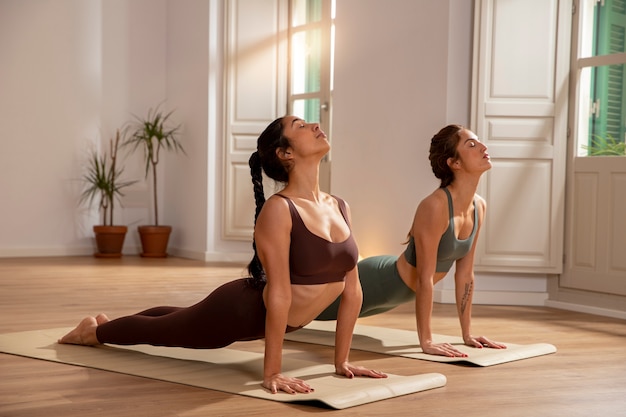
A yoga body isn’t just about flexible limbs; the ancient practice can also enhance memory and improve heart and bone health, according to Anna Magee.
Brits are now spending a whopping £790 million annually on yoga classes and equipment. While yoga has evolved into various quirky forms like rage yoga, naked yoga, and poses done on paddleboards or horseback, there is growing scientific evidence supporting its real benefits.
For instance, UCLA researchers found that a three-month yoga and meditation course was more effective than memory exercises at reducing age-related brain impairment. Another study noted improvements in sleep among breast cancer survivors who practiced yoga.
Lucy Edge, a former advertising executive, turned to yoga during a period of deep depression instead of taking prescribed anti-depressants. She took a six-month break, traveled to India to learn yoga, and returned with a profound sense of happiness and contentment. This experience inspired her to write books about yoga and establish Yoga Meds, a section of her website focused on yoga’s clinical benefits for various conditions.
If traditional brain exercises like crossword puzzles and Sudoku have been your go-to for memory training, it might be time to incorporate some yoga into your routine. UCLA research showed that adults over 55 who engaged in 12 weeks of yoga and meditation had better spatial and visual memory improvements compared to those who only did memory exercises. Additionally, the yoga group experienced less depression, anxiety, and greater resilience to stress.
You don’t need hours of headstands to see benefits. The study participants practiced one hour of Kundalini yoga weekly, which includes gentle movements, breathing techniques, meditation, and chanting. They also did 20 minutes of Kirtan Kriya daily, a meditation involving chanting, hand movements, and light visualization.
A significant body of evidence suggests that gentle yoga can be just as beneficial for heart health as conventional exercises like brisk walking. A review published in the European Journal of Preventative Cardiology in 2014 highlighted yoga’s potential to lower heart disease risks. Stress, a major contributor to heart disease, can be alleviated through yoga, which helps manage blood pressure and heart rate.
Dr. Mike Knapton of the British Heart Foundation endorses yoga’s impact on emotional health, noting its benefits for anxiety, stress, and depression—common conditions among heart disease patients.
For beginners, Charlotte Watts’s book, “The De-Stress Effect,” includes a series of stress-reducing gentle yoga poses. Anna Ashby from Triyoga Studios recommends Restorative yoga, which involves supported postures held for extended periods, promoting deep relaxation.
Musculoskeletal physiotherapist Sarah Shone saw the benefits of yoga firsthand and incorporated it into the Primary Care Trust’s back pain rehabilitation program, with 87% of participants reporting pain reduction. Guidelines by the National Institute of Clinical Excellence (NICE) include yoga as a beneficial exercise for lower back pain.
Yoga also targets pelvic floor muscles, helping with incontinence and supporting bone density through weight-bearing exercises. Beginners should inform their yoga teacher about any health concerns and start with gentler styles like Hatha or Iyengar yoga.
If you’re new to yoga or a seasoned practitioner, choosing the right yoga mat is crucial. Consider the mat’s thickness for joint protection, weight for portability, and length to match your height. Thicker mats provide better cushioning for a comfortable practice.
Healthista recommends the Valka Yoga Elephant Cork Yoga Mat, which is eco-friendly, durable, and offers excellent grip, especially for sweaty palms during hot yoga. Its natural antimicrobial properties ensure it remains odor-free. Alongside, the matching Valka yoga block can help ease into challenging poses, providing extra stability and grip compared to foam blocks.
Not flexible? No problem. Different yoga styles cater to various needs:
– Try Yin or Restorative yoga for a gentle practice with support props.
– Vinyasa Flow offers an energetic, breath-linked sequence, adaptable for beginners.
– Iyengar yoga focuses on precision and alignment, using props to assist poses.
– Anusara yoga combines alignment with flowing movements, often set to lively music.
– Yoga Therapy applies yoga to address specific injuries or illnesses, conducted by trained professionals.
Whether you’re starting with basic moves or looking to push your practice further, yoga offers something for everyone.